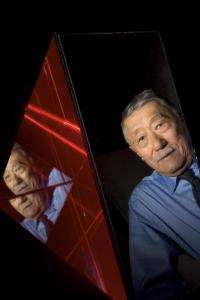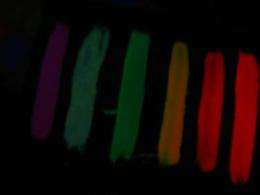UGA, UPR grant license for long-persistence glow materials, in any color

The University of Georgia Research Foundation, Inc. (UGARF) and the University of Puerto Rico have granted an international, non-exclusive license for a portfolio of glow-in-the-dark pigments that can be designed to emit light in any color of the visible spectrum for nearly a day. Performance Indicator, LLC, of Lowell, Mass., acquired the license.
Phosphorescence is a process in which energy absorbed by a substance is released relatively slowly in the form of light. Some materials release energy over long periods of time and are known as long-persistence phosphors. But scientists have puzzled over how to produce long-persistent phosphors that glow blue and green, red or other long-wavelength colors, or white.
By exploiting the phenomenon of energy transfer, the UGARF/UPR technology can produce long-lasting glow in any color, including blue, green or red, and in tints and hues, such as pink - red with white - without extensive modification to the composition of the materials.
The seven phosphors included in this patent portfolio are simple to manufacture and environmentally safe. They do not contain sulfur, radioactive materials, lead or other materials. They can be used in a multitude of consumer and industrial applications, including signage, special paints, and in combination with polymers for the manufacture of many items, such as color-coded electric wiring, insulation, textiles, novelty-items and printing ink.
The license to Performance Indicator allows it to adapt, patent, and market color-change or indicator technologies for a variety of industrial and consumer applications, and to import, manufacture and sell the phosphors. Also licensed under the same agreement are methods to customize the wavelength of emitted light, white-emitting phosphors, methods to render hues and tints to emitted light and methods to blend such phosphors with a multitude of materials, such as polymers and resins.
Performance Indicator has pioneered development of a photoluminescent technology that provides unmatched vibrancy and persistence, as well as an unprecedented palette of colors that can be formulated into a variety of fluids, coating or printing applications. In addition, PI has also discovered how to shift the emission of the base phosphors, through chemistry, into the infrared spectrum, expanding the uses of this technology platform into applications for covert military use and for commercialized anti-counterfeiting/authentication indicators.
Until recently, PI had focused primarily upon developing technologies that merely enhance the performance of phosphor pigments. However, complementing its chemical engineering advancements in these photoluminescent technologies, PI is also now actively engaged in research and development and small-scale manufacturing infrastructure toward the development of next-generation high-persistence phosphors for application in the security, defense, and energy sectors and plans to launch the only domestic plant to manufacture, sell, and distribute long-persistence phosphorescence materials.
"Our work in inventing novel ways to make phosphors (solid state physics) coupled with the revolutionary patented methods that we have developed around formulating phosphors for uses in practical and functional applications (chemistry), is unparalleled," said Robb J. Osinski, Performance Indicator co-founder. "It sets our technology platform far apart from any previous achievements in this field."

"The license granted by UGARF and the University of Puerto Rico enhances our intellectual property portfolio and the capabilities to deliver proprietary and, in many cases, customized photoluminescent-based solutions for a broad array of industrial and consumer applications," he added. "At the same time, it further enables Performance Indicator to import, manufacture, and sell phosphors."
The phosphors were developed under the guidance of the late William Yen, professor of physics, Franklin College of Arts and Sciences, University of Georgia, who was a pioneer in the field of long-persistence phosphorescence. Co-inventors are Weiya Jia, presently vice president of Performance Indicator, and Xiao-Jun Wang, associate professor of physics, Georgia Southern University. Yen and Jia pioneered the field of long-persistence phosphorescence and developed the first systematic approach to customize the color and duration of glow.
Yen held the Graham Perdue Chair in Physics at the University of Georgia from 1990 until his death in 2008. He was elected to the American Physical Society, the Optical Society of America, the American Association for the Advancement of Science, and the U.S. Electrochemical Society. Yen received numerous awards for his work, including the J. S. Guggenheim Fellowship and the A. von Humboldt Senior U.S. Scientist Award, as well as adjunct appointments at several universities. Yen was a principal editor of widely-used references on phosphors and phosphorescent technology, including Phosphor Handbook, Measurements of Phosphor Properties, Fundamentals of Phosphors and Practical Applications of Phosphors (all by CRC Press), as well as the Proceedings of Excon 98: Excitonic Processes.
Jia also is world-renowned in the creation of phosphorescent materials. Prior to joining the University of Puerto Rico, he held prominent positions at a variety of institutions, including the University of Georgia, the Chinese University of Science and Technology and the Chinese Institute of Physics.
Wang completed his graduate work at UGA under Yen. He is now an associate professor of physics at Georgia Southern University.
"Phosphorescent pigments are an important industrial segment. The U.S. color pigment industry was estimated to be around $2.5 billion in 2005 a year with projected growth around 6 percent until 2009. The phosphor segment may represent as much as 5 percent to 7 percent of this market," said Gennaro Gama, a senior technology manager with UGARF in charge of licensing the portfolio. "We found in Performance Indicator the qualities of a dedicated business partner, and this agreement represents a completely new and untapped business opportunity for UGARF and UGA's new generation of researchers working in this field."
Source: University of Georgia (news : web)

















